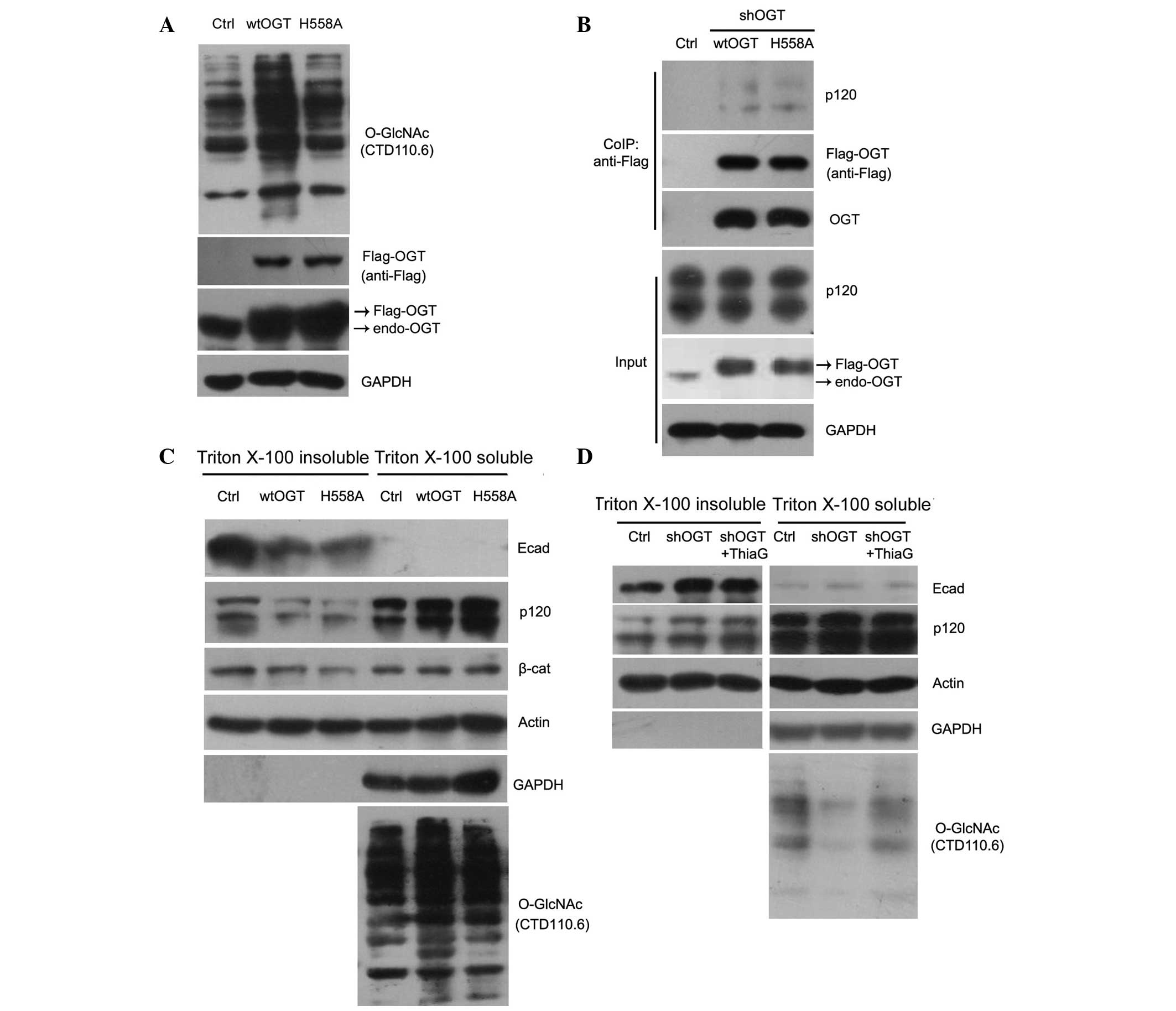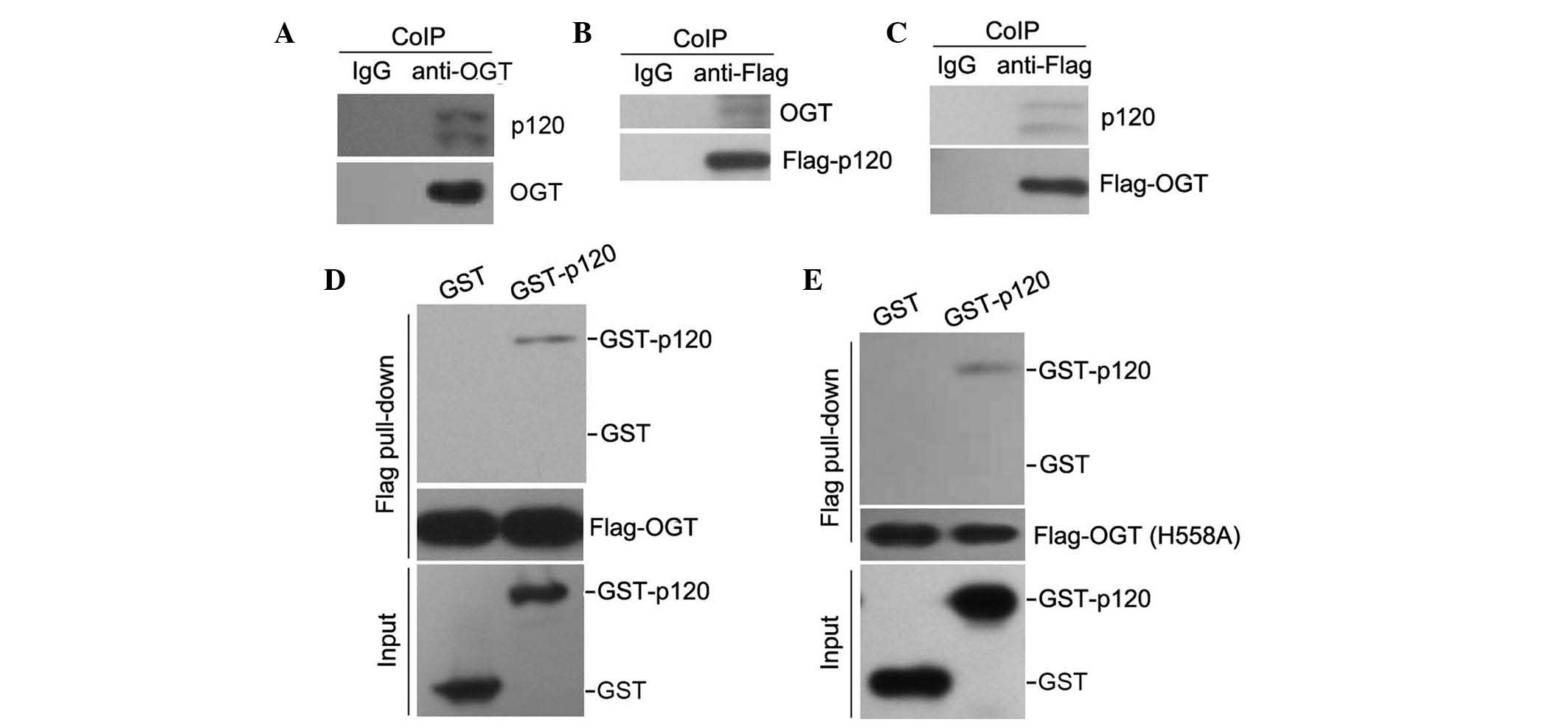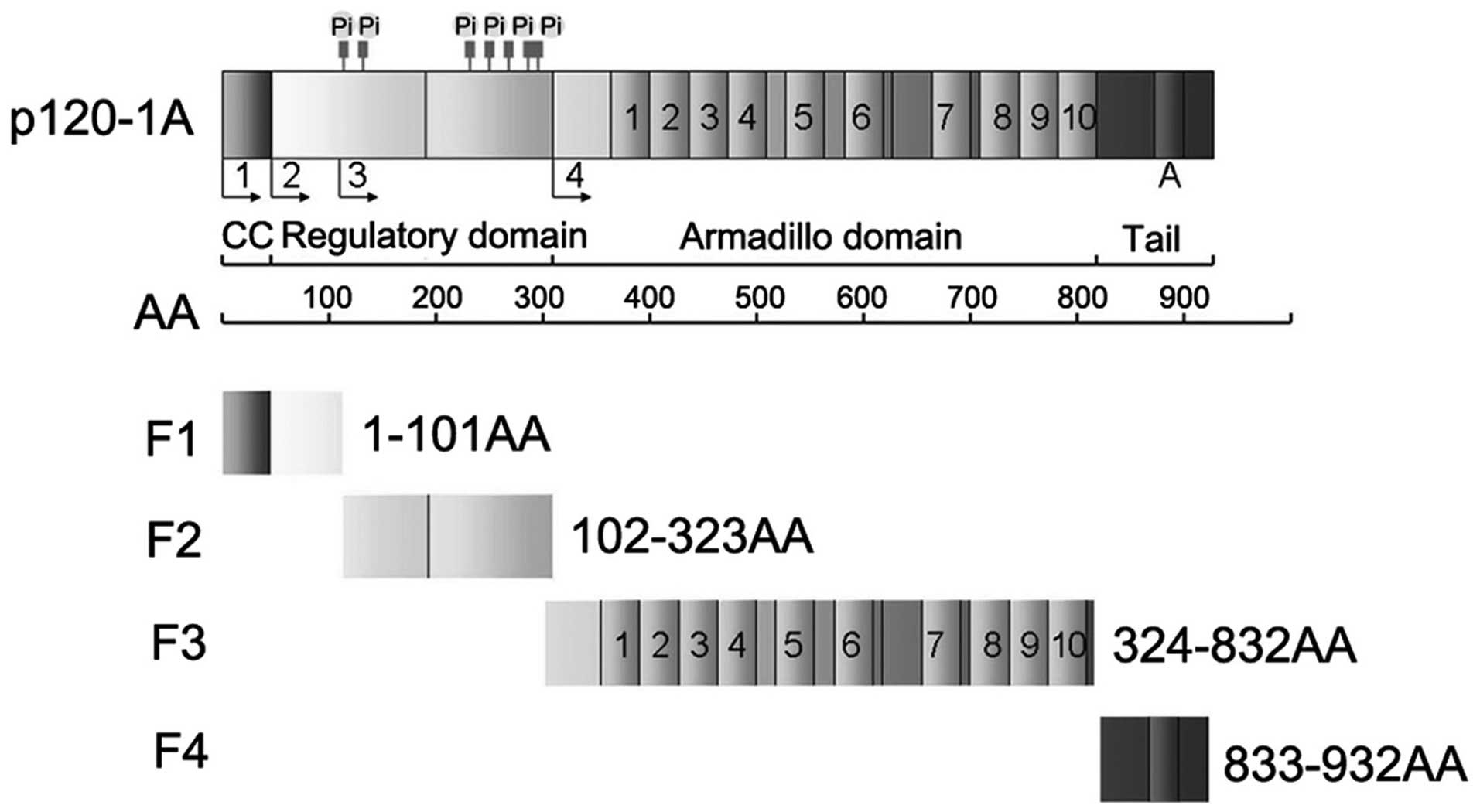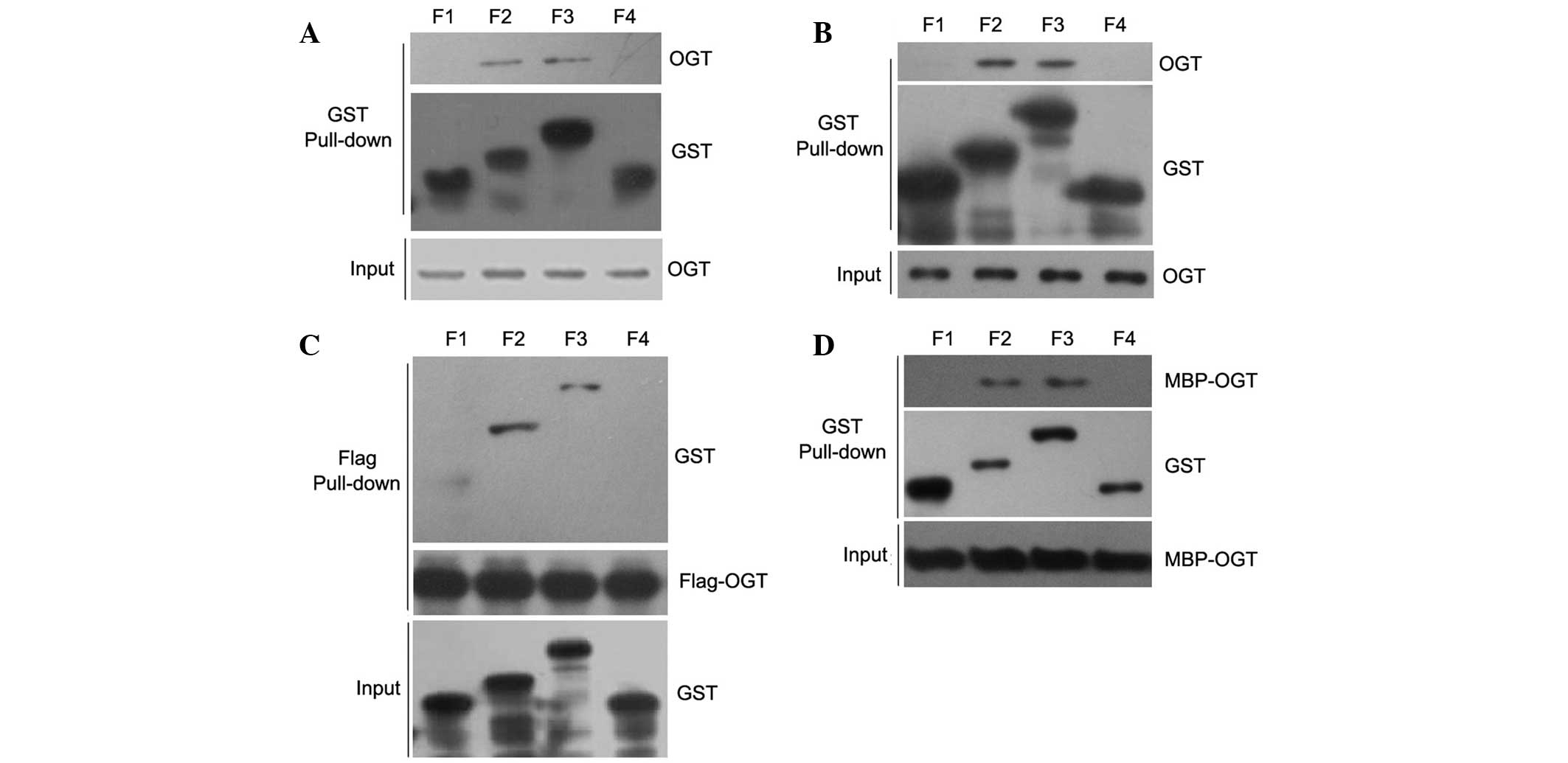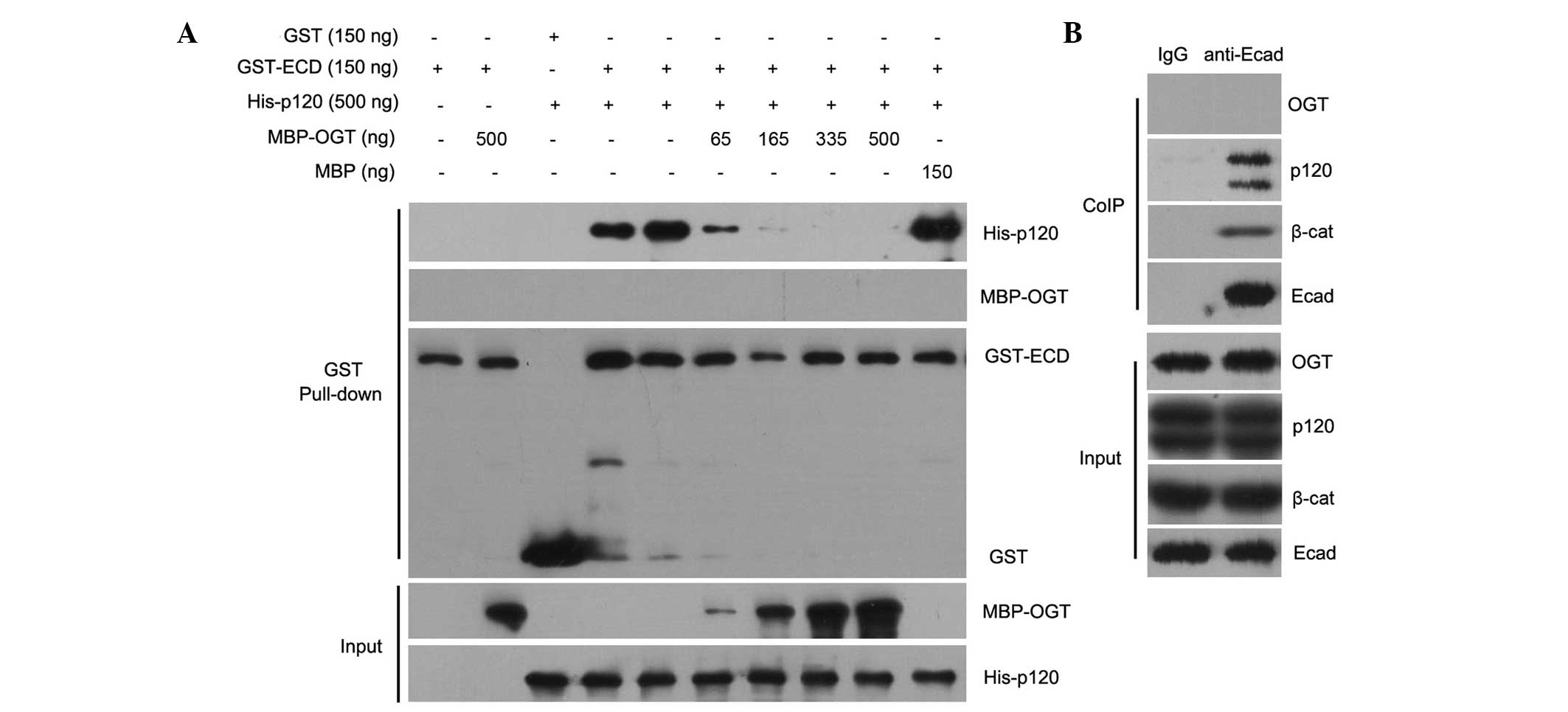|
1
|
Gumbiner BM: Cell adhesion: The molecular
basis of tissue architecture and morphogenesis. Cell. 84:345–357.
1996. View Article : Google Scholar : PubMed/NCBI
|
|
2
|
Jou TS, Stewart DB, Stappert J, Nelson WJ
and Marrs JA: Genetic and biochemical dissection of protein
linkages in the cadherin-catenin complex. Proc Natl Acad Sci U S A.
92:5067–5071. 1995. View Article : Google Scholar : PubMed/NCBI
|
|
3
|
Thoreson MA, Anastasiadis PZ, Daniel JM,
Ireton RC, Wheelock MJ, Johnson KR, Hummingbird DK and Reynolds AB:
Selective uncoupling of p120 (ctn) from E-cadherin disrupts strong
adhesion. J Cell Biol. 148:189–202. 2000. View Article : Google Scholar : PubMed/NCBI
|
|
4
|
Ishiyama N, Lee SH, Liu S, Li GY, Smith
MJ, Reichardt LF and Ikura M: Dynamic and static interactions
between p120 catenin and E-cadherin regulate the stability of
cell-cell adhesion. Cell. 141:117–128. 2010. View Article : Google Scholar : PubMed/NCBI
|
|
5
|
Nanes BA, Chiasson-Mackenzie C, Lowery AM,
Ishiyama N, Faundez V, Ikura M, Vincent PA and Kowalczyk AP:
p120-catenin binding masks an endocytic signal conserved in
classical cadherins. J Cell Biol. 199:365–80. 2012. View Article : Google Scholar : PubMed/NCBI
|
|
6
|
Ireton RC, Davis MA, van Hengel J, Mariner
DJ, Barnes K, Thoreson MA, Anastasiadis PZ, Matrisian L, Bundy LM,
Sealy L, et al: A novel role for p120 catenin in E-cadherin
function. J Cell Biol. 159:465–476. 2002. View Article : Google Scholar : PubMed/NCBI
|
|
7
|
Peifer M and Yap AS: Traffic control:
p120-catenin acts as a gatekeeper to control the fate of classical
cadherins in mammalian cells. J Cell Biol. 163:437–440. 2003.
View Article : Google Scholar : PubMed/NCBI
|
|
8
|
Keirsebilck A, Bonné S, Staes K, van
Hengel J, Nollet F, Reynolds A and van Roy F: Molecular cloning of
the human p120ctn catenin gene (CTNND1): Expression of multiple
alternatively spliced isoforms. Genomics. 50:129–146. 1998.
View Article : Google Scholar : PubMed/NCBI
|
|
9
|
Roura S, Miravet S, Piedra J, García de
Herreros A and Duñach M: Regulation of E-cadherin/catenin
association by tyrosine phosphorylation. J Biol Chem.
274:36734–36740. 1999. View Article : Google Scholar : PubMed/NCBI
|
|
10
|
Petrova YI, Spano MM and Gumbiner BM:
Conformational epitopes at cadherin calcium-binding sites and
p120-catenin phosphorylation regulate cell adhesion. Mol Biol Cell.
23:2092–2108. 2012. View Article : Google Scholar : PubMed/NCBI
|
|
11
|
Fukumoto Y, Shintani Y, Reynolds AB,
Johnson KR and Wheelock MJ: The regulatory or phosphorylation
domain of p120 catenin controls E-cadherin dynamics at the plasma
membrane. Exp Cell Res. 314:52–67. 2008. View Article : Google Scholar
|
|
12
|
Gu Y, Mi W, Ge Y, Liu H, Fan Q, Han C,
Yang J, Han F, Lu X and Yu W: GlcNAcylation plays an essential role
in breast cancer metastasis. Cancer Res. 70:6344–6351. 2010.
View Article : Google Scholar : PubMed/NCBI
|
|
13
|
Aslakson CJ and Miller FR: Selective
events in the metastatic process defined by analysis of the
sequential dissemination of subpopulations of a mouse mammary
tumor. Cancer Res. 52:1399–1405. 1992.PubMed/NCBI
|
|
14
|
Yang WH, Park SY, Nam HW, Kim do H, Kang
JG, Kang ES, Kim YS, Lee HC, Kim KS and Cho JW: NFkappaB activation
is associated with its O-GlcNAcylation state under hyperglycemic
conditions. Proc Natl Acad Sci USA. 105:17345–17350. 2008.
View Article : Google Scholar : PubMed/NCBI
|
|
15
|
Yuzwa SA, Yadav AK, Skorobogatko Y, Clark
T, Vosseller K and Vocadlo DJ: Mapping O-GlcNAc modification sites
on tau and generation of a site-specific O-GlcNAc tau antibody.
Amino Acids. 40:857–868. 2011. View Article : Google Scholar
|
|
16
|
Zhu W, Leber B and Andrews DW: Cytoplasmic
O-glycosylation prevents cell surface transport of E-cadherin
during apoptosis. EMBO J. 20:5999–6007. 2001. View Article : Google Scholar : PubMed/NCBI
|
|
17
|
Martinez-Fleites C, Macauley MS, He Y,
Shen DL, Vocadlo DJ and Davies GJ: Structure of an O-GlcNAc
transferase homolog provides insight into intracellular
glycosylation. Nat Struct Mol Biol. 15:764–765. 2008. View Article : Google Scholar : PubMed/NCBI
|
|
18
|
Pokutta S and Weis WI: Structure and
mechanism of cadherins and catenins in cell-cell contacts. Annu Rev
Cell Dev Biol. 23:237–261. 2007. View Article : Google Scholar : PubMed/NCBI
|
|
19
|
Takeichi M: Cadherins in cancer:
Implications for invasion and metastasis. Curr Opin Cell Biol.
5:806–811. 1993. View Article : Google Scholar : PubMed/NCBI
|
|
20
|
Stepniak E, Radice GL and Vasioukhin V:
Adhesive and signaling functions of cadherins and catenins in
vertebrate development. Cold Spring Harb Perspect Biol.
5:a0029492009.
|
|
21
|
Capaldo CT, Farkas AE and Nusrat A:
Epithelial adhesive junctions. F1000Prime Rep. 6:12014. View Article : Google Scholar : PubMed/NCBI
|
|
22
|
de Beco S, Amblard F and Coscoy S: New
insights into the regulation of E-cadherin distribution by
endocytosis. Int Rev Cell Mol Biol. 295:63–108. 2012. View Article : Google Scholar : PubMed/NCBI
|
|
23
|
Mosesson Y, Mills GB and Yarden Y:
Derailed endocytosis: An emerging feature of cancer. Nat Rev
Cancer. 8:835–850. 2008. View
Article : Google Scholar : PubMed/NCBI
|
|
24
|
Wheelock MJ, Shintani Y, Maeda M, Fukumoto
Y and Johnson KR: Cadherin switching. J Cell Sci. 121:727–735.
2008. View Article : Google Scholar : PubMed/NCBI
|
|
25
|
Fujita Y, Krause G, Scheffner M, Zechner
D, Leddy HE, Behrens J, Sommer T and Birchmeier W: Hakai, a
c-Cbl-like protein, ubiquitinates and induces endocytosis of the
E-cadherin complex. Nat Cell Biol. 4:222–231. 2002. View Article : Google Scholar : PubMed/NCBI
|
|
26
|
Alemà S and Salvatore AM: p120 catenin and
phosphorylation: Mechanisms and traits of an unresolved issue.
Biochim Biophys Acta. 1773:47–58. 2007. View Article : Google Scholar
|
|
27
|
Hart GW, Slawson C, Ramirez-Correa G and
Lagerlof O: Cross talk between O-GlcNAcylation and phosphorylation:
Roles in signaling, transcription and chronic disease. Annu Rev
Biochem. 80:825–858. 2011. View Article : Google Scholar
|
|
28
|
Wells L, Whelan SA and Hart GW: O-GlcNAc:
A regulatory post-translational modification. Biochem Biophys Res
Commun. 302:435–41. 2003. View Article : Google Scholar : PubMed/NCBI
|
|
29
|
Love DC, Krause MW and Hanover JA:
O-GlcNAc cycling: Emerging roles in development and epigenetics.
Semin Cell Dev Biol. 21:646–654. 2010. View Article : Google Scholar : PubMed/NCBI
|
|
30
|
Mi W, Gu Y, Han C, Liu H, Fan Q, Zhang X,
Cong Q and Yu W: O GlcNAcylation is a novel regulator of lung and
colon cancer malignancy. Biochim Biophys Acta. 1812:514–519. 2011.
View Article : Google Scholar : PubMed/NCBI
|
|
31
|
Liu Y, Li X, Yu Y, Shi J, Liang Z, Run X,
Li Y, Dai CL, Grundke-Iqbal I, Iqbal K, et al: Developmental
regulation of protein O-GlcNAcylation, O-GlcNAc transferase and
O-GlcNAcase in mammalian brain. PLoS One. 7:e437242012. View Article : Google Scholar
|
|
32
|
Capotosti F, Guernier S, Lammers F,
Waridel P, Cai Y, Jin J, Conaway JW, Conaway RC and Herr W:
O-GlcNAc transferase catalyzes site-specific proteolysis of HCF-1.
Cell. 144:376–388. 2011. View Article : Google Scholar : PubMed/NCBI
|
|
33
|
Pieters T, van Roy F and van Hengel J:
Functions of p120ctn isoforms in cell-cell adhesion and
intracellular signaling. Front Biosci (Landmark Ed). 17:1669–1694.
2012. View Article : Google Scholar
|
|
34
|
Castaño J, Solanas G, Casagolda D, Raurell
I, Villagrasa P, Bustelo XR, García de Herreros A and Duñach M:
Specific phosphorylation of p120-catenin regulatory domain
differently modulates its binding to RhoA. Mol Cell Biol.
27:1745–57. 2007. View Article : Google Scholar :
|
|
35
|
Lima VV, Giachini FR, Carneiro FS,
Carvalho MH, Fortes ZB, Webb RC and Tostes RC: O-GlcNAcylation
contributes to the vascular effects of ET-1 via activation of the
RhoA/Rho-kinase pathway. Cardiovasc Res. 89:614–622. 2011.
View Article : Google Scholar :
|
|
36
|
Kneass ZT and Marchase RB: Protein
O-GlcNAc modulates motility-associated signaling intermediates in
neutrophils. J Biol Chem. 280:14579–14585. 2005. View Article : Google Scholar : PubMed/NCBI
|



